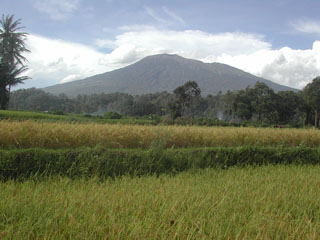Report on Marapi (Indonesia) — 8 May-14 May 2024
Smithsonian Institution / US Geological Survey
Weekly Volcanic Activity Report, 8 May-14 May 2024
Managing Editor: Sally Sennert.
Please cite this report as:
Global Volcanism Program, 2024. Report on Marapi (Indonesia) (Sennert, S, ed.). Weekly Volcanic Activity Report, 8 May-14 May 2024. Smithsonian Institution and US Geological Survey.
Marapi
Indonesia
0.38°S, 100.474°E; summit elev. 2885 m
All times are local (unless otherwise noted)
PVMBG reported that unrest at Marapi (on Sumatra) was ongoing during 8-14 May. White gas-and-steam plumes rose 200-300 m above the summit and drifted in multiple directions on most days; no emissions were visible on 10 May. An eruptive event was recorded on 10 May, though plumes were not visible.
Lahars generated by intense rainfall occurred around 2100 on 11 May and caused several fatalities, evacuations, and widespread damage in the Agam Regency. The lahars originated in the Malana or Lona drainage on Marapi’s flank and significantly impacted several areas including in the Agam, Tanah Datar, Padang Panjang, and Padang Pariaman districts. Aid efforts were delayed by damage to bridges and several sections of roads between villages. Close to 200 homes were damaged or missing, around 72 hectares of fields were affected, and mosques were damaged. Search-and-rescue efforts were suspended overnight during 11-12 May due to lack of light and continuing flooding in upstream areas. As of 1300 on 13 May there were 15 people that remained missing. The number of evacuees totaled 1,159 in the Agam Regency and 2,039 in the Tanah Datar Regency. Accordion to a news report the death toll reached 43 people on 15 May. The Alert Level remained at 3 (on a scale of 1-4), and the public was warned to stay 4.5 km away from the active crater.
Geological Summary. Gunung Marapi, not to be confused with the better-known Merapi volcano on Java, is Sumatra's most active volcano. This massive complex stratovolcano rises 2,000 m above the Bukittinggi Plain in the Padang Highlands. A broad summit contains multiple partially overlapping summit craters constructed within the small 1.4-km-wide Bancah caldera. The summit craters are located along an ENE-WSW line, with volcanism migrating to the west. More than 50 eruptions, typically consisting of small-to-moderate explosive activity, have been recorded since the end of the 18th century; no lava flows outside the summit craters have been reported in historical time.
Sources: Pusat Vulkanologi dan Mitigasi Bencana Geologi (PVMBG, also known as CVGHM), Badan Nacional Penanggulangan Bencana (BNPB), Antara News, Antara News

